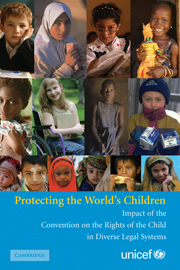 Protecting the World's Children
Protecting the World's Children Book contents
- Frontmatter
- Contents
- Acknowledgements
- Foreword
- Contributors
- Introduction and Overview
- 1 A Comparative Study of the Impact of the Convention on the Rights of the Child: Law Reform in Selected Common Law Countries
- 2 A Comparative Study of the Impact of the Convention on the Rights of the Child: Law Reform in Selected Civil Law Countries
- 3 A Comparative Perspective of the Convention on the Rights of the Child and the Principles of Islamic Law: Law Reform and Children's Rights in Muslim Jurisdictions
- 4 Law Reform and Children's Rights in Plural Legal Systems: Some Experiences in Sub-Saharan Africa
- Index
Introduction and Overview
Published online by Cambridge University Press: 30 October 2009
- Frontmatter
- Contents
- Acknowledgements
- Foreword
- Contributors
- Introduction and Overview
- 1 A Comparative Study of the Impact of the Convention on the Rights of the Child: Law Reform in Selected Common Law Countries
- 2 A Comparative Study of the Impact of the Convention on the Rights of the Child: Law Reform in Selected Civil Law Countries
- 3 A Comparative Perspective of the Convention on the Rights of the Child and the Principles of Islamic Law: Law Reform and Children's Rights in Muslim Jurisdictions
- 4 Law Reform and Children's Rights in Plural Legal Systems: Some Experiences in Sub-Saharan Africa
- Index
Summary
The Convention on the Rights of the Child (CRC) was adopted by the United Nations in 1989. It was the only international human rights Convention that came into force (on 2 September 1990) just one year after adoption. It is also the only Convention whose entry into force was accompanied by a major world conference that focused on implementation of the rights guaranteed by the treaty. A World Summit for Children of Heads of State gathered in New York at the end of September 1990, and adopted a Summit Declaration with specific goals and targets on implementation. Children, up to then the most invisible segment of society in the area of international human rights law, now had a Convention that was actually combined with a ‘World Plan of Action’, with goals and targets on implementation to be achieved within the next decade. One commitment in the Summit Declaration was universal ratification of the Convention by the beginning of a new millennium in 2000.
The United Nations Children's Fund (UNICEF) played a major role in the Summit meeting, and initiated a process that helped to ensure that the CRC was ratified by all countries, except Somalia and the United States of America, by 2000. Both Somalia and the United States have signed the treaty and thus indicated their intention to ratify. However, to date Somalia does not have an established government, and the United States has, up to now, failed to ratify the Convention.
- Type
- Chapter
- Information
- Protecting the World's ChildrenImpact of the Convention on the Rights of the Child in Diverse Legal Systems, pp. 1 - 33Publisher: Cambridge University PressPrint publication year: 2007
